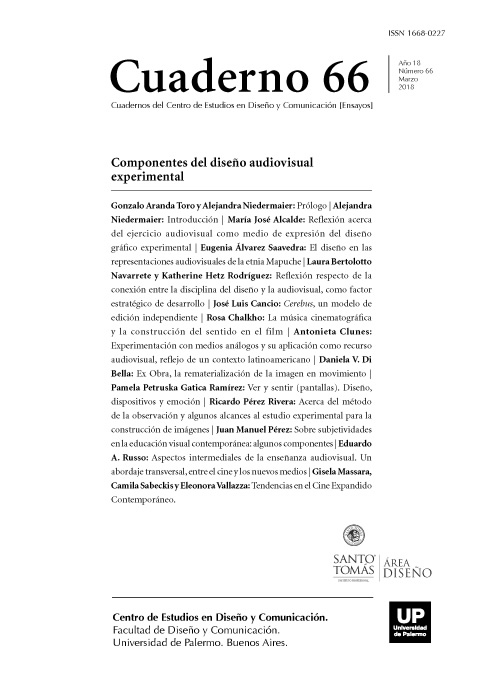Reflexión acerca del ejercicio audiovisual como medio de expresión del diseño gráfico experimental
Abstract
This article proposes a reflection about experimental design focusing on the teaching-learning process.
References
Ballantyne, R., Packer, J. (2002). Nature based excursions: school studentes percepctions of learning in natural environments, en International research in geographical and environmental education.
Bolls & otros. (2001). The effects of message valence and listener arousal on attention, memory, and facial muscular responses to radio advertisements.
Burch, N. (1998). Praxis del cine Fundamentos. Colección arte, serie cine. Madrid.
Chisholm, C. U. (2009). The characterization of work-based learning by consideration of the theories of experiential learning, en European Journal of Education.
Deleuze, G. (1984). Estudios sobre cine. Barcelona: Instituto de Investigaciones GFK.
Dillon, J., Rickinson, M., Teamey, K., Morris, M., Young Choi, M., Benefield, P., Department for education and skills, Nottingham, UK. (2006). Learning outside the classroom manifesto.
Eaton, D. (2000). Congnitive and affective learning: evidence in outdoor education, en Dissertation abstracts International, Section A: Humanities and social sciences.
Epstein, S. (1994). Integration of the cognitive and the psychoanalytical unconscious.
Garcia, F.; Portillo, J.; Romo, J.; Benito, M. (2007). Nativos digitales y modelos de aprendizaje. Universidad de País Vasco / EuskalHerrikoUnibertsitatea (UPV/EHU). Desde: http://spdece07.ehu.es/actas/Garcia.pdf
Itin, C. M. (1999). Reasserting the philosophy of experiential education as vehicle for change in the 21st. Century, en Journal of experiential education.
Lang, A., (1995). The effects of emotional arousal and valence on television viewers, en Journal of broadcasting and electronic media.
Moreira, M. A. (2010). Aprendizaje significativo: Un concepto subyacente. Instituto de Física, UFRGS, Campus 91501-970. Porto Alegre, RS, Brasil. Desde: http://www.if.ufrgs.br/~moreira/apsigsubesp.pdf
Morales, L. F. (2009). La Fusión Audiovisual y su relación con la captación de la atención de los mensajes. Desde: http://www.razonypalabra.org.mx/N/n67/varia/lfmorales.html
Mitry, J., (2002). Estética y psicología del cine.
Openshaw, P. H.; Whittle, S. J. (1993). Ecological field teaching: How can it be made more effective?, en Journal of biological education.
Orion, N.; Hofstein, A. (1994). Factors that influence learning during a scientific field trip in a natural environment, en Journal of research in science teaching.
Pozo, J. I. (1999). Aprendices y Maestros: La nueva cultura del aprendizaje.
Reeves, B. & otros (1999). The effects of screen sie and message content on attention and arousal.
Romero Ariza, M. (2010). El aprendizaje experiencial y las nuevas demandas formativas. Revista de Antropología experimental n° 10. Especial Educación 8: 89-102. Universidad de Jaen (España). Desde: http://revista.ujaen.es/huesped/rae/articulos2010/edu1008pdf.pdf
Smith, M. K. (2001). David A Kolb on experiential learning, The encyclopedia of informal education. Desde: http://infed.org/mobi/david-a-kolb-on-experiential-learning/
Uzzel, D. L.; Rutland, A.; Whistance, D. (1995). Questioning values in environmental education.
Los autores/as que publiquen en esta revista ceden los derechos de autor y de publicación a "Cuadernos del Centro de Estudios de Diseño y Comunicación", Aceptando el registro de su trabajo bajo una licencia de atribución de Creative Commons, que permite a terceros utilizar lo publicado siempre que de el crédito pertinente a los autores y a esta revista.


